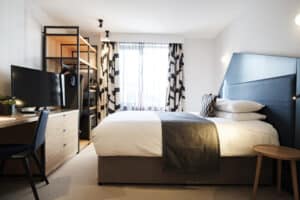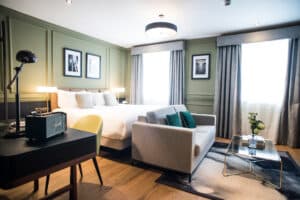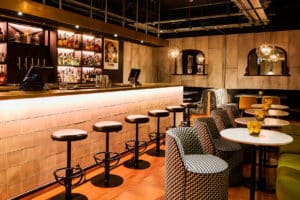When designing a hotel guest room, the aesthetics are crucial. The style sets the tone of the hotel, and in the modern world, great imagery is fundamental to selling rooms. However, at Sibley Grove, we believe that to create the perfect room we have to look beyond aesthetics to how a room functions and feels. Hotel stays, good and bad, are a sensory experience.
This article provides ten essential tips for designing the perfect hotel guest room: details that are often overlooked but are pivotal in ensuring that your guests have a memorable and enjoyable stay.
1. The Bed: The Centre of Comfort
The bed is the centrepiece of any hotel guest room and the place where guests will spend the majority of their time. The primary function of a hotel guest room is to provide the guest with a great night’s sleep. Therefore, anything less than perfection is a problem.
Getting the bed wrong can undo all of the hard work that’s been invested in other areas. If sleep quality is compromised, then the entire stay is undermined.
Unless the room doesn’t allow it, go for a Super King mattress (1800mm x 2000mm) as standard and Emperor (2000mm x 2000mm) if possible. Ensure mattresses are supportive and well-ventilated so guests stay cool and comfortable.
2. The Perfect Shower: Simplicity and Functionality
Of equal importance to the bed is the shower. Selecting great quality fixtures and fittings is important, but so too is the sizing and setting out. Select a minimum 800mm wide shower tray for comfortable showering with an overhead shower and hand shower. Make sure you provide ample space to store toiletries in the form of shelves or wall-mounted baskets.
The placement of valves and thermostats is crucial, and they should be easily accessible from outside the shower enclosure. Guests should be able to adjust the water temperature and flow without having to step into the shower.
Finally, position towel rails logically so guests can reach their towels without having to step outside of the shower enclosure.
3. Acoustics: Ensuring a Peaceful Environment
Like a badly chosen bed, noise can destroy an otherwise perfect stay. Always ensure doors are acoustically sealed and that upgrades are made to neighbouring walls, floors and ceilings if needed. Noise is often overlooked in the design process, but is one of the most frequent complaints that hoteliers receive.
4. Achieving Complete Darkness for Restful Sleep
Achieving complete darkness in a hotel room is another crucial factor in delivering a great night’s sleep. Ensure curtains are lined with blackout fabric to block any light from outside sources. It is also important to choose floor-to-ceiling curtains that extend at least 300 mm beyond the window’s width on each side. This placement ensures that no unwanted light seeps into the room. Another helpful tip is to install a box pelmet on top of the curtains or to recess the curtain track into the ceiling to prevent light from spilling over the top.
5. Bathroom Vanity: Providing Ample Space for Guests
When designing a hotel room, we must consider how the space is presented upon arrival, but also how the room will accommodate the guest’s belongings. The bathroom vanity is one area where this is felt most.
The modern traveler can come with a vast collection of toiletries and seldom relies on those provided by the hotel itself. The vanity must provide ample space to unpack, organise and use products, as well as generous mirrors, considerate lighting and power for devices.
6. Thoughtful Luggage Storage Solutions
A common problem in hotel room design is that spaces are carefully designed for clothes and accessories, but the luggage with which the guest arrives is forgotten, creating clutter.
Ideally, guest rooms should have specific areas for luggage, such as shelves or compartments within wardrobes. Under-bed storage is also a great location for empty luggage.
7. Cushion Clutter
Cushions are a great way to add colour, pattern and texture to a room, but too many can be a problem, making a room feel cluttered and cramped.
Most hoteliers will tell you that bed cushions are often thrown onto the floor by guests when they need to get into bed, as there is nowhere else for them to go. We always specify bed cushions but will make sure chairs or sofas can accommodate them.
8. Less is More: Avoiding Furniture Overload
When designing a hotel room, don’t crowd it with furniture. Space is a quality, and too much furniture can make a room feel unnecessarily cluttered and cramped.
From the hotel’s point of view, additional furniture adds to the capital cost. It also makes housekeeping and maintenance more time-consuming, costing time and money. If furniture is not serving a purpose, consider if it is needed.
9. Think Like a Guest: Ensuring Adequate Electrical Outlets
Give careful consideration to the placement of electrical sockets. Provide points at the desk and bed for the charging of personal devices and ensure they are visible and easily accessible. Guest should not have to climb underneath furniture to access plugs.
Always ensure mirrors have sockets close by for hairdryers and place power in bathroom vanities for electrical devices such as toothbrushes and shavers.
10. Aromas and Ambiance: Incorporating Scent Design
Consider the impact of different sensory elements when designing a hotel guest room, including smell. Adding thoughtful scents can enhance the guest’s stay. Scents can elevate the sensory experience and help establish consistency and a brand identity.




